Author: Will Lovell
Of all the variable that go into making a quality batch of beer, a few seem to get the most focus, one being yeast pitch rate. Indeed, yeast are the living organisms responsible for turning the wort brewers make into delicious beer, so it makes to give them some deserved attention. Yeast viability refers to the quantity of living cells in a given population, and it increases during fermentation while, meaning post-fermentation is typically quite a bit higher than what was originally pitched.
Brewers are well aware of recommendations when it comes to yeast pitch rate and often make an effort to neither underpitch nor overpitch, as both are said to increase the risk of off-flavors. However, a common practice among some brewer involves transferring fresh wort onto the entire yeast cake used to ferment a prior batch, which can easily result in an overpitch for lower OG styles, though is viewed by many as a good way to ensure good viability when making stronger beers.
I recently brewed a Belgian Single for The Brü Club’s AvgBrü series, and there was a recommendation to use the yeast cake for a subsequent AvgBrü Belgian Dark Strong Ale. With a couple past xBmts suggesting fermenting on yeast cakes has a perceptible impact, I was curious how doing so would effect a higher OG Belgian Dark Strong Ale and designed an xBmt to see for myself.
| PURPOSE |
To evaluate the differences between a Belgian Dark Strong Ale fermented with the yeast cake from a previous batch and one fermented with fresh pouch of yeast.
| METHODS |
Since this beer was brewed for The Brü Club’s AvgBrü project, I went with a recipe based largely on the agreed upon guidelines.
AvgBrü Belgian Dark Strong Ale
Recipe Details
| Batch Size | Boil Time | IBU | SRM | Est. OG | Est. FG | ABV |
|---|---|---|---|---|---|---|
| 6.5 gal | 60 min | 24.3 | 26.8 SRM | 1.068 | 1.008 | 7.88 % |
| Actuals | 1.068 | 1.008 | 7.88 % | |||
Fermentables
| Name | Amount | % |
|---|---|---|
| Llano Pilsner | 14 lbs | 71.79 |
| Brown Sugar, Dark | 1 lbs | 5.13 |
| Candi Syrup, D-180 | 1 lbs | 5.13 |
| Candi Syrup, D-45 | 1 lbs | 5.13 |
| Crystal 60l | 1 lbs | 5.13 |
| Caramel Malt 40L | 12 oz | 3.85 |
| Special B | 8 oz | 2.56 |
| Aromatic Malt | 4 oz | 1.28 |
Hops
| Name | Amount | Time | Use | Form | Alpha % |
|---|---|---|---|---|---|
| Magnum | 9 g | 60 min | Boil | Pellet | 16.5 |
| Saaz | 45 g | 15 min | Boil | Pellet | 4.4 |
Yeast
| Name | Lab | Attenuation | Temperature |
|---|---|---|---|
| Triple Double (B48) | Imperial Yeast | 78% | 64.9°F - 77°F |
Notes
| Water Profile: Ca 79 | Mg 8 | Na 0 | SO4 94 | Cl 93 |
Download
| Download this recipe's BeerXML file |
A few hours before starting this brew, I kegged a Belgian Single that was done fermenting then collected the entire yeast cake in a separate vessel. I purposefully opted not to transfer fresh wort into the used fermenter in order to eliminate that as an extraneous variable. The fresh yeast and yeast cake were left out next to each during my brew day.
After adding identical volumes of water to separate Delta Brewing AIO units, adjusting each to the same mineral profile, then I set the controllers to heat them up before milling the grain.
When the water for each batch was adequately heated, I incorporated the grains then set the controllers to maintain them at the same target mash temperature.
While the mashes were resting, I prepared the kettle hop additions.
Once each 60 minute mash was complete, I removed the grains then proceeded to boil the worts for 60 minutes, adding hops as listed in the recipe.
When the worts were done boiling, I took refractometer readings showing they were at essentially the same OG.
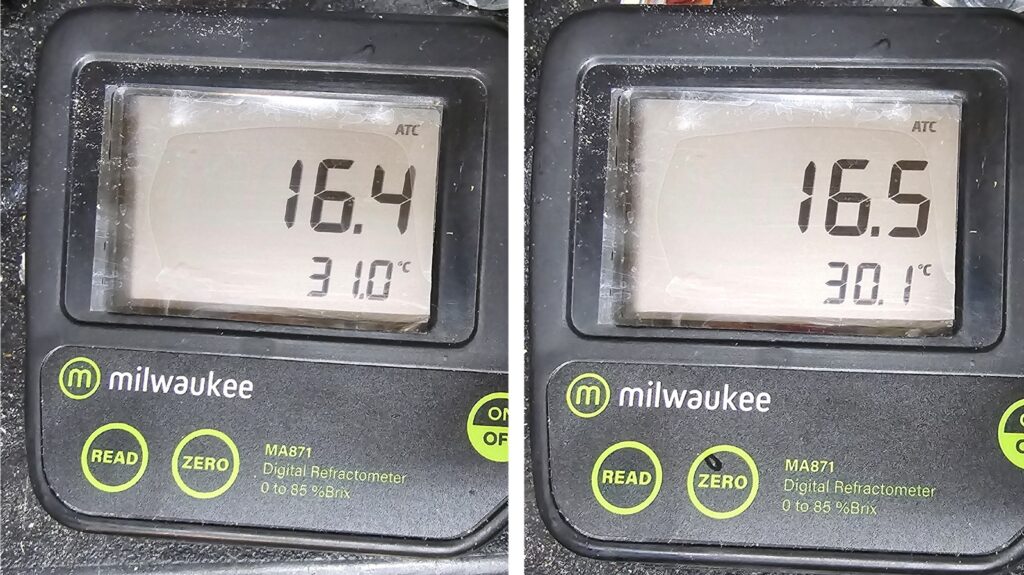
I transferred identical volumes of wort to Delta Brewing FermTanks that were attached to my glycol system and left to finish chilling to my desired fermentation temperature. Within 20 minutes, both worts were stabilized at 66°F/19°C, so I pitched a pouch of Imperial Yeast B48 Triple Double into one wort while the other received the yeast cake of the same strain from a prior Belgian Single fermentation.
Two days into fermentation, I added the Belgian candi syrup to both batches.
With signs of activity absent 9 days later, I took hydrometer measurements showing both beers were at the same FG, which is unsurprising considering the variable had yet to be introduced.
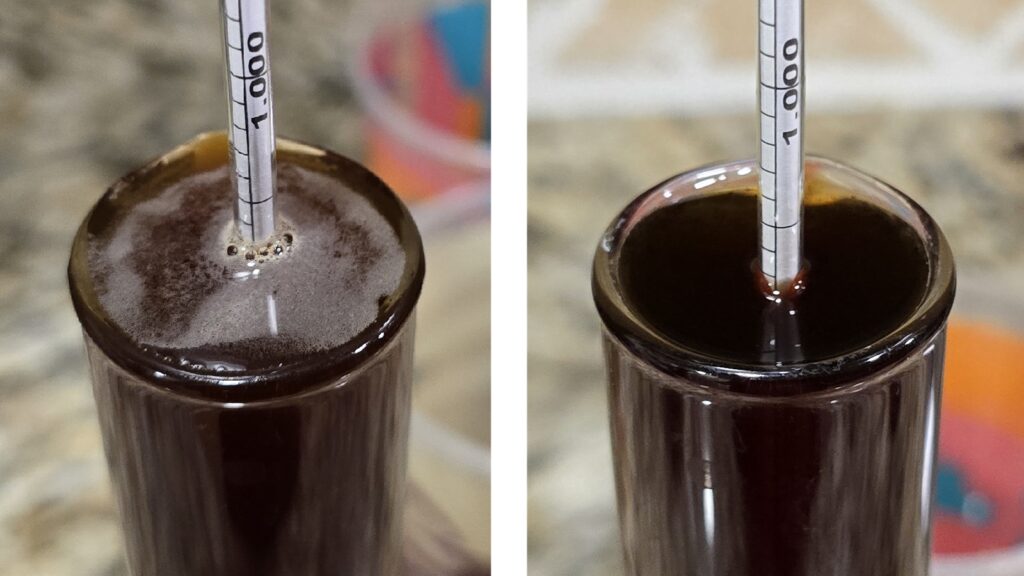
At this point, I cold crashed the beers overnight before pressure transferring them to CO2 purged kegs that were placed on gas in my keezer. After a few weeks of conditioning, they were ready for evaluation.

| RESULTS |
A total of 21 people of varying levels of experience participated in this xBmt. Each participant was served 1 sample of the beer fermented with yeast pitched directly from the pouch and 2 samples of the beer fermented with a yeast cake in different colored opaque cups then asked to identify the unique sample. While 12 tasters (p<0.05) would have had to accurately identify the unique sample to reach statistical significance, only 6 did (p=0.75), indicating participants in this xBmt were unable to reliably distinguish a Belgian Dark Strong Ale that was fermented with a single pouch of yeast from one that was fermented with yeast slurry previously used to fermented a Belgian Single.
My Impressions: Out of the 5 semi-blind triangle tests I attempted, I correctly identified the odd-beer-out just once, and that was a complete guess. These beers were identical in every way to my senses, which was a good thing, as I felt they were excellent examples of Belgian Dark Strong Ale.
| DISCUSSION |
Pitching the right amount of yeast is viewed by most brewers as being key to achieving a high-quality beer, whereas underpitching can result in poor attenuation and undesirable off-flavors while overpitching can lead to a thin body, muted ester profile, and an unpleasant yeasty flavor. Interestingly, tasters in this xBmt were unable to reliably distinguish a Belgian Dark Strong Ale that was fermented with a single pouch of yeast from one that fermented with the yeast cake from a prior batch of Belgian Single.
Based on Brewfather calculations, this Belgian Dark Strong Ale called for a yeast pitch rate of 415 billion cells, which is ostensibly over double what was in the Imperial Yeast pouch that, at its freshest, contains 200 billion cells. More accurately determining the number of cells in the yeast cake is difficult, but it’s safe to say it was an overpitch considering it was pitched with the entire slurry from a prior batch. One possible explanation for tasters’ inability to distinguish these beers is that, if there were any differences caused by yeast pitch rate, they were covered up by the notable fermentation characteristics associated with Imperial Yeast B48 Triple Double.
While my anecdotal experience validates the pitching of a single pouch of yeast when making a variety of styles including Belgian Dark Strong Ale, I maintained some expectation that the batch fermented with the yeast cake would have lower ester levels and noticeable yeasty flavor. Of course, that wasn’t the case, which aligns with the results of a couple past yeast pitch rate xBmts focused on Saison and Weissbier. I’ll generally stick with pitching a pouch of yeast, as it’s arguably lower risk for contamination, but in a pinch, I’d have no issues fermenting a characterful style like Belgian Dark Strong Ale with a yeast cake.
If you have any thoughts about this xBmt, please do not hesitate to share in the comments section below!
Support Brülosophy In Style!
All designs are available in various colors and sizes on Amazon!
Follow Brülosophy on:
FACEBOOK | TWITTER | INSTAGRAM
If you enjoy this stuff and feel compelled to support Brulosophy.com, please check out the Support page for details on how you can very easily do so. Thanks!


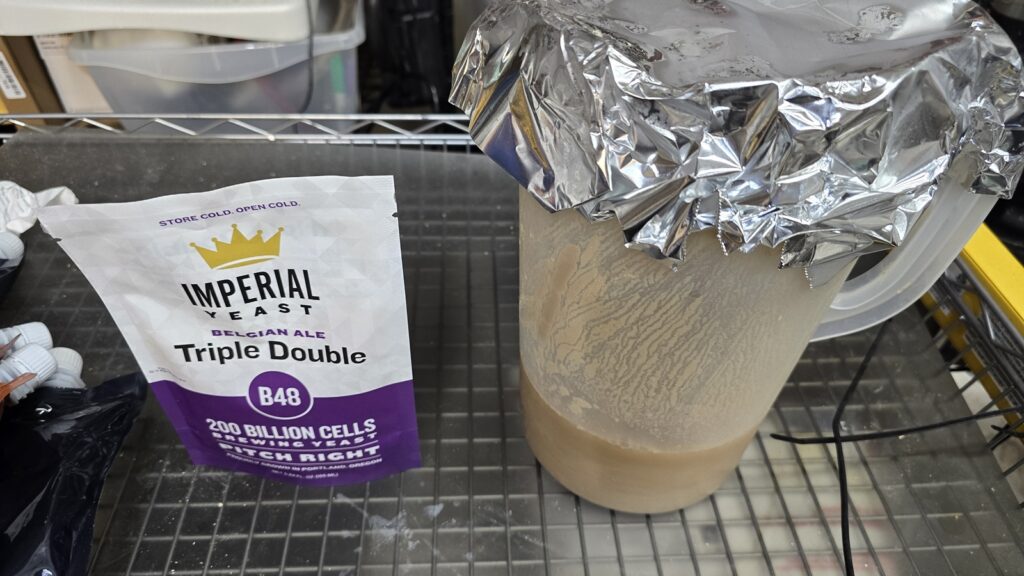
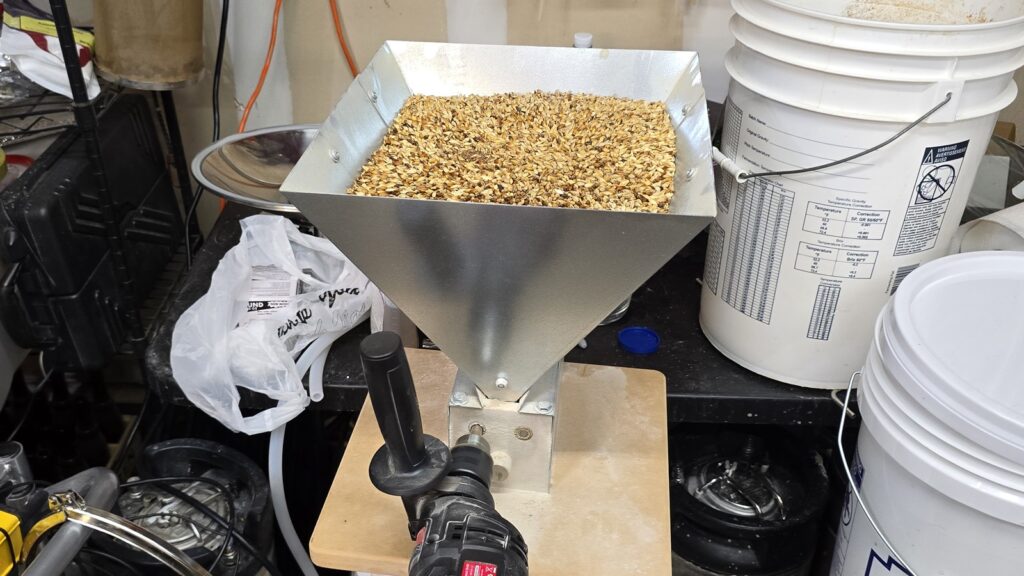
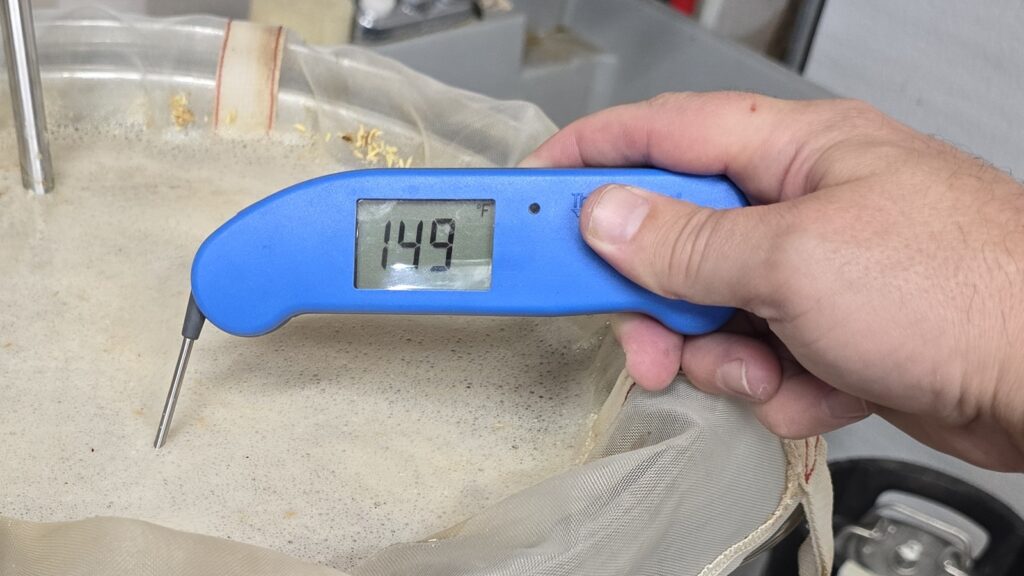

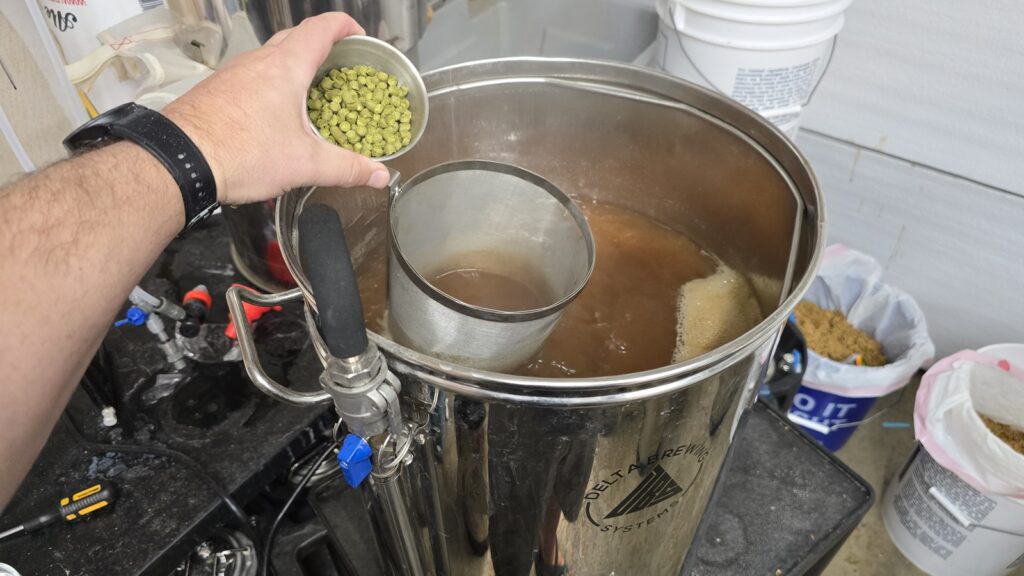
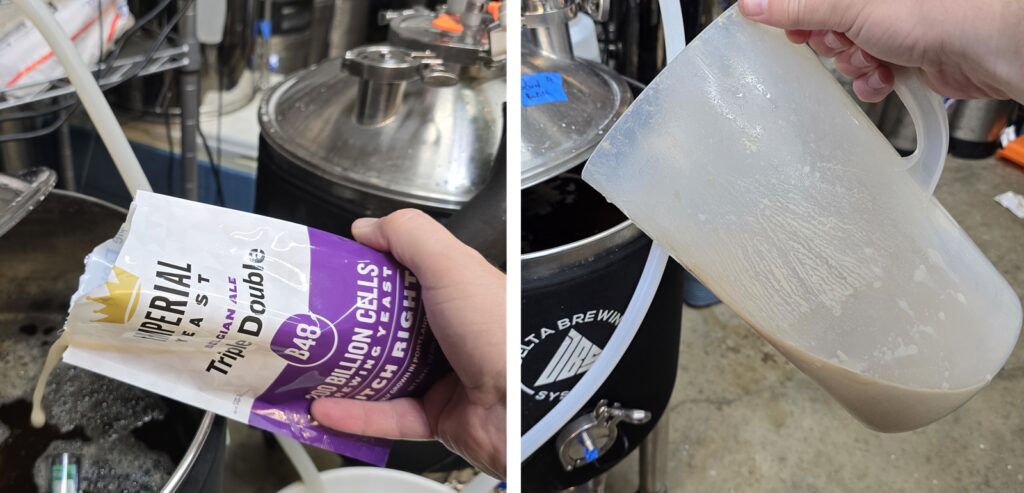
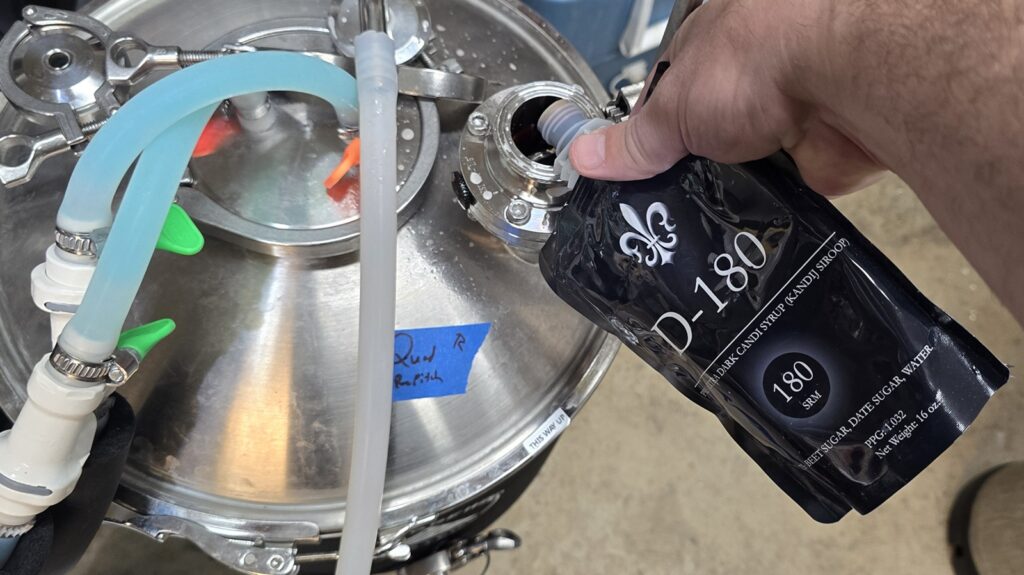





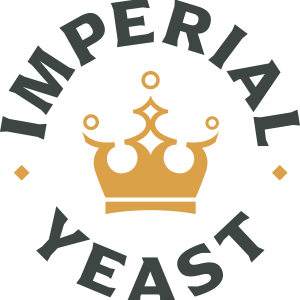

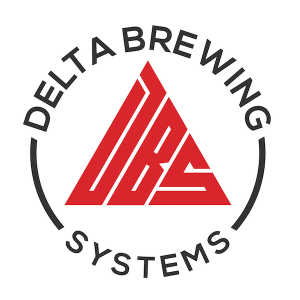


4 thoughts on “exBEERiment | Yeast Pitch Rate: Direct Pitch vs. Yeast Cake In A Belgian Dark Strong Ale”
I calculate yeast pitch rate for ales at .3 million cells per ml per percent brix. You brewed 24.5 liters at 16.8 OG meaning bare minimum is 124 billion cells. Your packet gives 200 billion (depending how much are really viable). It looks to me like you pitched at or slightly higher the necessary rate for both beers which is likely why there is hardly a difference. The method of aeration wasn’t given but given that both beers had a good portion of pils malt with likely a high amount of FAN and both yeasts were very healthy, off flavors from slight overpitching wouldn’t really occur. Its also been show that esther production is more influenced from yeast strain as well as fermentation vessel and fermentation under pressure, temperature, aeration and pitch rate offer minimal esthers. I would say you could push the experiment further and pitch half a package of yeast but at under pitching so extremely, you’d run in to problems like stalling.
It’s easy to get away with doing this for a couple of batches. The third-ish batch is when it will be disastrous. Yeast cells in wort need to divide for optimum health. With a massive overpitch, they do not divide, as the wort is already at or over max cell density. Come that third-ish batch, the cells will be too spent to ferment well. This is when you will taste the autolysis.
In my experience that does not happen, or at least not with every yeast strain. A few years ago I propagated and pitched 10mil cell/ml/*Plato of 2124 into a pilsner and reused that yeast pitch 12 times over the next 10 months. I oxygenated every batch and supplemented with 5g/23L Fermaid O. I waited for a weird fermentation to happen but no such luck. Just really clean, fast(FG in 2-3 days, cold crashed in 5-7), fermented(at 44-46F/7-8C) lagers with no d-rest or anything.
Idk if it was the oxygen, yeast nutrient, or just dumb luck, but I got bored of 2124 before that huge pitch of yeast misbehaved for me.
This beer is outside of style guidelines for OG (below the bottom by 10%), FG (also low) and SRM (over). When I think of using a yeast cake for a big beer, I think of a bigger beer than this.